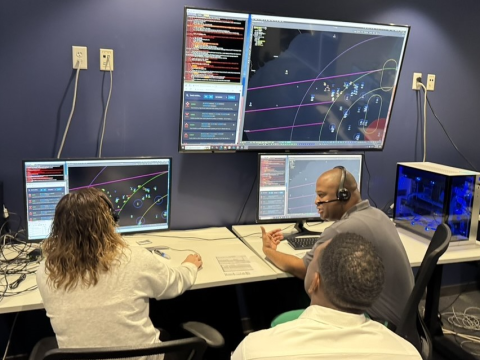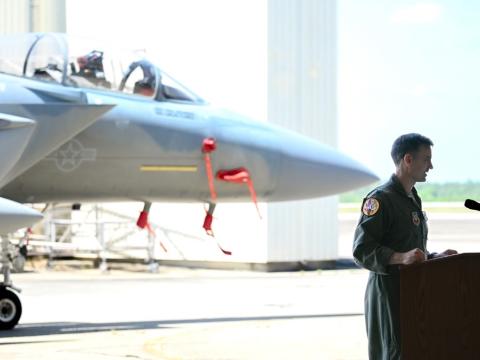Airmen Fix Energy on the Horizon
Whether above, on land or in cyberspace, mission assurance is the goal behind advancements in power sources.
The U.S. Air Force is planning an energy future in which it both leads and follows the technology efforts of others. Improved efficiencies as well as alternative technologies will play key roles in giving the Air Force supremacy in energy as well as in the air. The future of the Air Force’s fundamental research into energy through the year 2026 is outlined in a report designed to maintain the service’s position as the pre-eminent entity in air and space. Titled Energy Horizons, the paper offers plans for power-source science and technology (S&T) not only in the expected air and space arenas, but also in cyberspace and infrastructure.
Contributors note that an assured energy advantage can enable victory in battle. Creating that advantage depends both on furthering substitute energy sources and on changing approaches to current ones. The report serves as the S&T blueprint and vision enabling the Air Force Energy Plan, articulating how scientific advances help the Air Force reach its overall objectives.
But technology alone is not the answer to all of the service’s energy needs. One of the three primary goals in the Air Force Energy Plan is an adjustment in the norms of behavior regarding energy usage. Dr. Mark T. Maybury, the Air Force’s chief scientist, explains that reducing energy intensity “requires you to change your culture.” He adds that Energy Horizons lays out S&T advances necessary to achieve that objective along with the other two goals of reducing demand and increasing supply.
A dilemma for S&T professionals—and everyone in the defense realm—is reduced budgets. Maybury says he wants to encourage funding in his areas, because they enable the military to realize more cost benefits and capability. “Efficiency often comes from S&T,” he explains. “Many innovations have made the U.S. Air Force the best in the world.” He adds that, in a sense, the budget crunch helped direct the report by forcing leaders to pinpoint the critical activities that must be accomplished. The document states that S&T “promises advances that translate into operational advantages, including cost savings, energy resiliency, system robustness and operational readiness.”
The Air Force has plenty of use for all those promises. It is the largest single consumer of energy in the federal government, spending $9.7 billion on fuel and electricity in fiscal year 2011, up $1.5 billion from fiscal year 2010. The increase occurred even as airmen have decreased their overall energy consumption by 17 percent since 2003. Expenditures for aviation fuel drive the service’s energy costs and jumped from $6.8 billion to $8.3 billion in one year. Such changes are not a steady increase, but instead an unpredictable rise and fall that follows the volatile price of fuel.
From an economic perspective, the most important area to address is energy for aircraft. In fiscal year 2010—the annual numbers used in the report—the more than $8 billion that went to power aviation made up 84 percent of the Air Force’s total budget. The cost of energy for the space mission, by contrast, was $103 million, almost all for terrestrial facilities associated with assets in space. “That’s significant,” Maybury states. “Clearly from an efficiency perspective and a taxpayer return on investment, air is primary.” Facilities made up 12 percent of the budget; only 4 percent went toward vehicles and equipment.
To help reduce the amount of fossil fuels the Air Force uses in its aircraft, it is experimenting with 50/50 mixes of synthetic fuel and traditional JP-8 jet fuel as well as biofuel mixed with JP-8. Maybury says the Air Force also is close to a cellulosic biofuel made from sources such as corn husks and other nonedible plant products. “The primary motivation—because we are a military organization—is mission assurance,” he states. However, the service branch has a responsibility to be a steward of the planet because airmen and Air Force civilians live in the world; the Air Force also has a duty to reduce costs to taxpayers, he adds.
At the same time, airplanes must be able to fly faster, higher and longer. Energy Horizons contains the classic Breguet range equation that demonstrates how to derive more distance on less fuel through more efficient engines. Maybury explains that the Air Force soon will ground-test two new aircraft engines in the Adaptive Versatile Engine Technology, or ADVENT, program that will have on average 25 percent fuel efficiency improvement over current designs because of a third air flow, more efficient cores and improved designs. “Twenty-five percent efficiency is revolutionary,” he states.
Such measures help ensure energy advantage. “It’s advantage because it’s comparative,” Maybury says. With the advancements, airmen can establish bases farther from each other, and missions can last longer. Or, aircraft can travel the same distances, but sorties cost less money.
Moving forward, energy for cyberpurposes will grow in importance, as it remains both a domain in its own right and an enabler for other domains. The report states that, “In the cyber domain, efficient algorithms and processors and cloud computing promise not only energy savings but also enhanced cyber resiliency.” Four strategic thrusts are delineated to guide S&T investment toward the Air Force’s cyber energy vision in the 2020s. They are: empower the mission, optimize human/machine systems, enhance agility and resilience, and invent new foundations.
According to Energy Horizons, airmen will contend with increased dependency on cyber; continued size, weight and power reductions; and sustained technological advancement. Moore’s Law will slow, but nanotechnology and 3-D packaging will accelerate. Intelligently distributed energy should help alleviate the potential dangers of expanded interconnectivity and threats to critical infrastructure.
Reduced costs also are important in the cyber realm, and the Air Force aims to cut the high price of climate control in data centers. At one location, the service is addressing potential overheating concerns by running water across processors to perform thermal management. Maybury says energy management must be addressed across a total systems perspective. Lowering data centers’ energy requirements would boost the Air Force toward meeting goals and mandates while improving mission capabilities.
Sample technologies identified by the report as potentially assisting in maintaining an improved cyber energy posture include the introduction of low-power/instant-on, instant-off computing technologies, the use of low-power clusters and the employment of cloud computing to distribute computing centers to low-cost energy regions. In addition, the report states that, “Revolutionary advances in energy efficient computing will deliver new mission capabilities such as bug-sized micro-miniature air and space vehicles with extreme size, weight and power constraints, as well as spin-off technology advances impacting large-scale data centers.”
Computers themselves continue to grow in efficiency, further reducing energy requirements. The Air Force has one of the most energy-efficient supercomputers in the world—Condor—which employs 1,716 PS3s that run in standby mode using only 5 watts of power each. When they are turned on via a user reservation system, they use approximately 100 watts. “Analogously, your smartphone preserves energy—and its battery—by powering down when not in use,” Maybury explains. Running the entire cluster consumes 256 kilowatts. When the computer nodes are powered off, the supercomputer is reduced to a minimum energy footprint of 11 kilowatts to support user log-in, network switching and shared file servers. “Condor uses an interactive scheduler to provide resources to the end users while effectively and efficiently managing the resources that are required,” Maybury says.
Another area increasing energy efficiency is improved battery technology. Maybury explains that civilians have different requirements for batteries than the military. For the most part, average Americans have ample opportunity to recharge these power sources, but in space or on long military flights, fewer chances to recharge are available. The Air Force is starting to electrify its unmanned systems fleet to reduce the need for liquid fuels and will require extended battery life to do so. Officials are examining photovoltaic cells to provide the necessary power for those systems and other needs similar to the way they power space assets.
Maybury calls the use of hybrid technology “one of the more interesting things we discovered in space.” However, the current record for efficiency in the technology is 42.5 percent, meaning that less than half the energy collected from the sun through the cells is converted into usable power. Normal photovoltaic cells qualified by the Air Force for space use operate at about 30 percent efficiency.
Increased efficiency of satellite photovoltaics, propulsion and payloads not only can save energy, but it also can lengthen and assure space missions, because flying up replacement power sources is expensive and risky. “Imagine more efficient satellite propulsion or onboard processing or batteries with significantly extended life,” Maybury says. In space, batteries must cycle exponentially more times than on Earth. If a battery in a computer or other device depletes once a day, that results in 365 charges a year. A power source that survives 5,000 charges could last the life of the platform. But away from Earth, batteries need to charge continually, and satellites or other vehicles are not always looking at the sun. “There’s no plug in space,” Maybury says.
Air Force officials realize airmen will not serve as the initiators for all the S&T advancements necessary across the spectrum of energy. Personnel involved with producing the document discussed the included topics with members of industry, academia, laboratories and government agencies as they created the report. Energy Horizons details the operational energy needs and mandates for each domain, making capability-specific recommendations for focusing on each in the near- (one to five years), mid- (six to 10 years) or far-term (10 to 15 years). Technologies with application across Air Force domains also are addressed.
The report articulates the areas in which the Air Force will be a leader, a follower or a watcher. For example, the service branch will be a leader in implementing petroleum-replacement technologies but a follower in increasing efficiency of current wind and solar technologies. In the cloud computing arena, airmen expect to lead the way in efficient and optimal computing and servers as well as in security measures. In other areas related to cloud computing, they will wait to see what develops in outside research arenas. Taking a back-seat role in certain areas will allow the Air Force to adopt other organizations’ solutions rapidly, to adapt advancements to its needs or to augment funding.
WEB RESOURCES
Energy Horizons: www.af.mil/shared/media/document/AFD-120209-060.pdf
Air Force Energy Plan 2010: www.safie.hq.af.mil/shared/media/document/AFD-091208-027.pdf
Dr. Mark T. Maybury Biography: www.af.mil/information/bios/bio.asp?bioID=14038




Comments